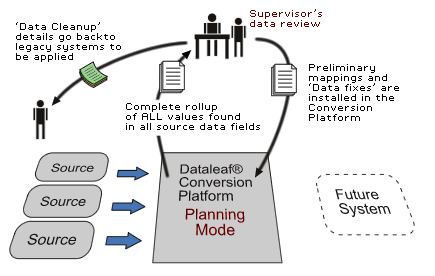
Dataleaf Technologies, Inc: HR System migration, archiving, analysis, modeling, interim HRIS
Dataleaf® Conversion Process (page 1)
[first of 4 pages]
To see how the Dataleaf® Conversion Platform focuses on efficiency in the data conversion process, let's look at how the Platform — a rather complex database — does quadruple duty, leveraging four different tasks on the same conversion control database.
Task 1: Planning Support
Usually, in the very first few days of a system migration project, we load a complete set of legacy system source data into the Dataleaf® Conversion Platform.
This data is rolled up, by value, for every single field, and the result is published in Excel and packaged as a portable application to assist supervisors in planning, mapping, and data correction.

Task 1: Planning Support
Annotated records are re-introduced into the Dataleaf® Conversion Platform to provide permanent data fixes and a preliminary mapping of values. In the Planning process, 'Data Cleanup' is distinguished from 'Data Fixes' because data cleanup involves interactive admin in the legacy application, whereas data fixes reside permanently in the Conversion Platform, and are applied (and generate audit trail entries) whenever the platform is triggered.
A Typical Sequence of Events for Dataleaf® Conversion Platform 'Planning Support' :
- During the first week of the project, a full data load is provided to the Platform and analysis is performed. In general, more data sources will be used in this initial load than will ultimately be needed for the final conversion -- since one major purpose of this load is to decide which sources to use and how to combine them.
- About the middle of the second week of the project, Dataleaf confers with legacy system supervisors. All individual conferees have a complete reference inventory of all values and all fields at their fingertips, either in paper or automated form. This inventory is emitted by the Dataleaf® Conversion Platform.
- During this conference (which generally takes 1-2 hours for a given supervisor) supervisors may (1) supply identification for unknown codes; (2) prescribe permanent data fixes to be applied through the Platform; (3) request any number of additional data reports, to be prepared by Dataleaf and furnished to the supervisor in convenient form, to resolve data questions; (4) define data cleanup activities to take place within the legacy system.
- Based on this conference, Dataleaf generally has enough information
to populate its data mapping database in a preliminary 'skeleton' form
Also based on this conference, Dataleaf generally has enough information to start generating trial conversion loads. The main value of creating trial conversion loads very early in the project is to exercise the data-loading process. (It is too early for business critique of the loaded data!) - After the conference with supervisors, Dataleaf turns around research requests in about one business day.
Benefits of 'Planning Support' via the Dataleaf® Conversion Platform
- Data decisions made in the second week of the project -- in the presence of a fully-analyzed data corpus -- rarely need to be changed as the project continues. This accelerates the entire project.
- Data fixes, data cleanup, and mapping are all part of a single, unified process designed to optimize -- in this case, concentrate and expedite -- the use of client staff resources.
- Mappings and automated data fixes are handled in a disciplined way on the Dataleaf® Conversion Platform, and a very solid, tight audit trail is created, supported by a client-friendly audit trail database.
- Almost from the beginning, the term 'Percent Complete' has a precise meaning for each of many project dimensions within the Dataleaf® Conversion Platform, because the quantitative dimensions of nearly all problems are known up front.
- Conversion Process:
- .. page 1
- .. page 2
- .. page 3
- .. page 4
- <- Back to Data Conversion
planning features...
Data fixes, data cleanup, and mapping are all part of a single, unified
process
A very solid, tight audit
trail is created, supported by a client-friendly audit trail database.
The term 'Percent Complete' has a precise meaning for each of many project dimensions within the Dataleaf® Conversion Platform.
